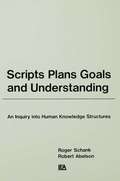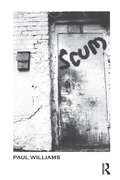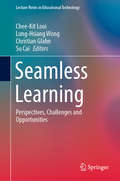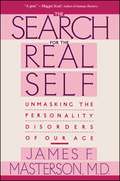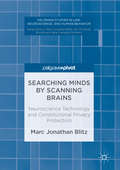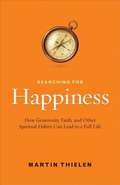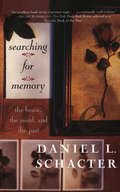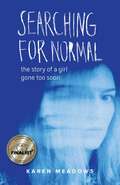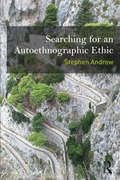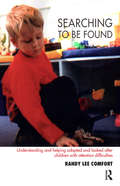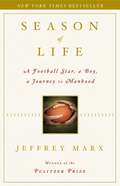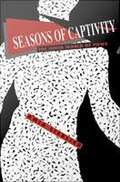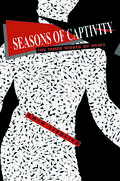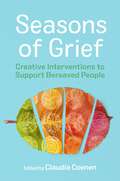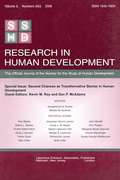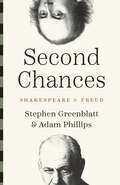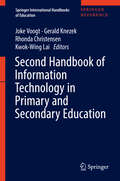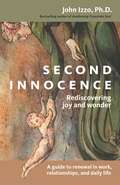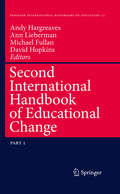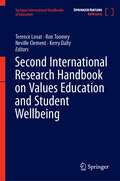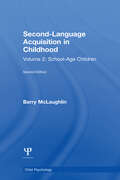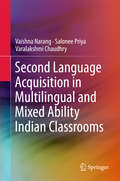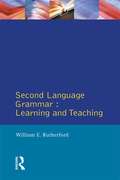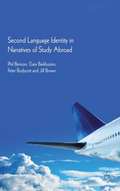- Table View
- List View
Scripts, Plans, Goals, and Understanding: An Inquiry Into Human Knowledge Structures (Artificial Intelligence Series)
by Robert P. Abelson Roger C. SchankFirst Published in 1977. Routledge is an imprint of Taylor & Francis, an informa company.
Scum
by Paul Williams'Scum is a masterfully written book in which the author, by means of a particularly effective form of fragmentation of language, captures the disjunctive experience of a terrified boy. The life of the boy and the life of the sentences are lived entirely in the collision of the will to survive and the impossible demands of an incomprehensible, utterly senseless reality. There are no happy endings in Williams' books, but far more valuable is the vitality that is generated in his deft and original use of language.' - Thomas Ogden
Seamless Learning: Perspectives, Challenges and Opportunities (Lecture Notes in Educational Technology)
by Chee-Kit Looi Lung-Hsiang Wong Christian Glahn Su CaiThis book introduces readers to the latest state of research and development in seamless learning. It consolidates various approaches to and practices in seamless learning from a range of techno-pedagogical, socio-situated and socio-cultural perspectives. Further, it details our current understanding of learning in both formal and informal settings, crossover learning, incidental learning, and context-based learning approaches, together with these aspects’ linkages to the notion of seamlessness. The book is divided into sections addressing the theorization of seamless learning, understanding informal learning, research methodological issues, technology-enabled seamless learning and real-world applications of seamless learning. Rounding out the coverage, the final chapter proposes a research agenda for the next 10 years.
Search For The Real Self
by James F. MastersonPersonality disorders--borderline, narcissistic, and schizoid--have become the classic psychological disorders of our age. Outwardly successful, charming and powerful, personality-disordered individuals have long confounded their colleagues, family, lovers and employees--as well as mental health professionals. The author helps the reader understand them. After describing how the healthy real self develops and functions, he explains what can go wrong. Drawing on case histories, he shows how the false self behaves in relationships and on the job, and then delineates appropriate treatments, offering real hope for cure.
Search For The Real Self: Unmasking the Personality Disorders of Our Age
by James F. MastersonPersonality disorders - borderline, narcissistic and schizoid - have become the classic psychological disorders of our age. Outwardly successful, charming and powerful, personality-disordered individuals have long confounded their colleagues, family, lovers and employees - as well as mental health professionals. The author helps the reader understand them. After describing how the healthy real self develops and functions, he explains what can go wrong. Drawing on case histories, he shows how the false self behaves in relationships and on the job, and then delineates appropriate treatments, offering real hope for cure.
Searching Minds by Scanning Brains: Neuroscience Technology and Constitutional Privacy Protection (Palgrave Studies in Law, Neuroscience, and Human Behavior)
by Marc Jonathan BlitzThis book examines the ethical and legal challenges presented by modern techniques of memory retrieval, especially within the context of potential use by the US government in courts of law. Specifically, Marc Blitz discusses the Fourth Amendment’s protections against unreasonable searches and the Fifth Amendment's self-incrimination clause. He also argues that we should pay close attention to another constitutional provision that individuals generally don’t think of as protecting their privacy: The First Amendment’s freedom of speech. First Amendment values also protect our freedom of thought, and this—not simply our privacy—is what is at stake if government engaged in excessive monitoring of our minds.
Searching for Happiness : How Generosity, Faith, And Other Spiritual Habits Can Lead To A Full Life
by Martin ThielenThe key to happiness is being rich, successful, and beautiful…right? Martin Thielen, best-selling author of What's the Least I Can Believe and Still Be a Christian?, insists that this is far from the truth. Happiness, Thielen argues, does not come from external factors like getting a job promotion or finally reaching your goal weight. Rather, happiness is an inside job. <P><P>In brief, easy-to-read chapters, Thielen offers ten traits of happy and fulfilled people. Using psychological research, personal anecdotes, and Scripture, Thielen begins the path to contentment by showing how life circumstances—including income, health, physical appearance, and marital status—only account for about 10 percent of a person's overall life satisfaction. From there, he offers alternatives to the frequent methods we use to make ourselves happy. Instead of aiming to make more money, Thielen contends that expressing gratitude and cultivating optimism are surer paths to joy. Rather than focusing on constant advancement in our careers, let's practice our ability to forgive, to be generous, and to use trials as growth opportunities. These lessons, and much more, help readers who may be dissatisfied in their lives see that authentic contentment is closer than they ever imagined. <P><P>The book features a guide for group or individual study, which includes questions for reflection and a challenge for each individual to reflect on during the week.
Searching for Memory: The Brain, the Mind, and the Past
by Daniel L. SchacterMemory. There may be nothing more important to human beings than our ability to enshrine experience and recall it. While philosophers and poets have elevated memory to an almost mystical level, psychologists have struggled to demystify it. Now, according to Daniel Schacter, one of the most distinguished memory researchers, the mysteries of memory are finally yielding to dramatic, even revolutionary, scientific breakthroughs. Schacter explains how and why it may change our understanding of everything from false memory to Alzheimer’s disease, from recovered memory to amnesia with fascinating firsthand accounts of patients with striking--and sometimes bizarre--amnesias resulting from brain injury or psychological trauma.
Searching for Normal: The Story of a Girl Gone Too Soon
by Karen MeadowsKaren Meadows had a normal, happy family until depression consumed her daughter, Sadie—a struggle that ended with Sadie&’s suicide at age eighteen. In Searching for Normal, Meadows shares her family&’s journey as she tries to help her daughter Sadie cope with her mental illness, expertly intertwining her own storyline with excerpts from her daughter&’s diaries. The years Meadows chronicles are characterized by Sadie&’s heartbreaking bouts of running away, cutting, and living with Portland street families while Karen and her husband desperately search for solutions—trying medication, hospitals, therapy, wilderness and residential treatment programs, and more. Ultimately, however, they find themselves confronted with the devastating shortcomings of the US&’s mental health system. Including hindsight advice from Meadows, along with an extensive list of resources that she wishes someone had provided her when she was trying to help Sadie, this book will help parents of struggling teens feel less isolated and better equipped to navigate their teenager&’s mental illness. : Meadows also describes recent developments that are paving the way for better diagnoses and treatment options.
Searching for an Autoethnographic Ethic (Writing Lives: Ethnographic Narratives)
by Stephen AndrewThis volume is a call for integrity in autoethnographic research. Stephen Andrew weaves together philosophy, critical theory, and extended self-reflections to demonstrate how and why qualitative researchers should assess the ethical quality of their work. He also offers practical tools designed to limit the likelihood of self-indulgence and solipsism in first-person writing. Equally instructive and exemplary, his work: Is written in a relatable style that draws readers in and encourages them to think critically about the implications and effects of their writing. Examines the history of qualitative and autoethnographic research. Provides implementable strategies for textualizing lived experiences and relationships with others.
Searching to be Found: Understanding and Helping Adopted and Looked After Children with Attention Difficulties
by Randy Lee ComfortA practical, supportive book for adoptive parents, carers, teachers and other professionals who live and work with families and children whose happiness and behaviours are affected by attention difficulties and hyperactivity. The examples of real children and adults in everyday situations translate research findings into meaningful strategies for helping families, teachers and children to find more successful means of managing difficult behaviours and emotions.
Season of Life: A Football Star, a Boy, a Journey to Manhood
by Jeffrey MarxJoe Ehrmann, a former NFL football star and volunteer coach for the Gilman high school football team, teaches his players the keys to successful defense: penetrate, pursue, punish, love. Love? A former captain of the Baltimore Colts and now an ordained minister, Ehrmann is serious about the game of football but even more serious about the purpose of life. Season of Life is his inspirational story as told by Pulitzer Prize-winning journalist Jeffrey Marx, who was a ballboy for the Colts when he first met Ehrmann. Ehrmann now devotes his life to teaching young men a whole new meaning of masculinity. He teaches the boys at Gilman the precepts of his Building Men for Others program: Being a man means emphasizing relationships and having a cause bigger than yourself. It means accepting responsibility and leading courageously. It means that empathy, integrity, and living a life of service to others are more important than points on a scoreboard. Decades after he first met Ehrmann, Jeffrey Marx renewed their friendship and watched his childhood hero putting his principles into action. While chronicling a season with the Gilman Greyhounds, Marx witnessed the most extraordinary sports program he'd ever seen, where players say "I love you" to each other and coaches profess their love for their players. Off the field Marx sat with Ehrmann and absorbed life lessons that led him to reexamine his own unresolved relationship with his father. Season of Life is a book about what it means to be a man of substance and impact. It is a moving story that will resonate with athletes, coaches, parents -- anyone struggling to make the right choices in life.
Seasons of Captivity
by Amia Lieblich"[An] engrossing study, told mainly by the subjects themselves... a valuable addition to POW literature and unique for its positive view of wartime captivity."-Publishers Weekly "Lieblich has skillfully integrated oral histories to produce a compelling story."-Library Journal "The minutes of the meetings recorded hereby are an excerpt of the lives of ten men, who had spent all their days and nights together. Each one observed the other in his grief and joy.Each one, according to his ability and sensitivity, saw it as his duty to contribute to the general welfare, to save our boat from sinking....In fact, we managed to keep afloat most of the time, and if we erred here or there, at least we had the best intentions."-From a secret collective diary kept by ten POWs A national bestseller when it first appeared in Israel, Seasons of Captivity is a story of human survival and hope that documents the experience of ten Israeli prisoners of war who shared a single jail cell in Egypt for more than three years. The engrossing chronicle of the prisoners' ordeal is told in their own words-from their capture in 1969, through six months of interrogation, torture, and isolation, to their movement to a common room. A watershed event, their transfer to shared living quarters enabled them to forge a community and an almost utopian social system. They held weekly meetings, kept a common diary, started study classes, and, among other projects, translated The Hobbit into Hebrew. The narrative goes on to describe the re-entry of the POWs into family and social roles upon their release and return to Israel in 1973. An exploration of the personal impact of the experience on the wives of the married prisoners introduces the women's own stories of separation and reunion. Some of them had suddenly found themselves, in effect, single mothers-yet their husbands were alive. Their husbands found stronger, more independent women in place of the traditional ones they had left behind. One of the women remarks, I thought [my husband] had been angry at me, in part unconsciously, for being so strong and competent in his absence...I had managed, well, almost effortlessly. This dramatic and moving account illustrates the resilience of the human spirit in the face of the most dehumanizing circumstances.
Seasons of Captivity: The Inner World of POWs
by Amia Lieblich"[An] engrossing study, told mainly by the subjects themselves... a valuable addition to POW literature and unique for its positive view of wartime captivity."-Publishers Weekly "Lieblich has skillfully integrated oral histories to produce a compelling story."-Library Journal "The minutes of the meetings recorded hereby are an excerpt of the lives of ten men, who had spent all their days and nights together. Each one observed the other in his grief and joy.Each one, according to his ability and sensitivity, saw it as his duty to contribute to the general welfare, to save our boat from sinking....In fact, we managed to keep afloat most of the time, and if we erred here or there, at least we had the best intentions."-From a secret collective diary kept by ten POWs A national bestseller when it first appeared in Israel, Seasons of Captivity is a story of human survival and hope that documents the experience of ten Israeli prisoners of war who shared a single jail cell in Egypt for more than three years. The engrossing chronicle of the prisoners' ordeal is told in their own words-from their capture in 1969, through six months of interrogation, torture, and isolation, to their movement to a common room. A watershed event, their transfer to shared living quarters enabled them to forge a community and an almost utopian social system. They held weekly meetings, kept a common diary, started study classes, and, among other projects, translated The Hobbit into Hebrew. The narrative goes on to describe the re-entry of the POWs into family and social roles upon their release and return to Israel in 1973. An exploration of the personal impact of the experience on the wives of the married prisoners introduces the women's own stories of separation and reunion. Some of them had suddenly found themselves, in effect, single mothers-yet their husbands were alive. Their husbands found stronger, more independent women in place of the traditional ones they had left behind. One of the women remarks, I thought [my husband] had been angry at me, in part unconsciously, for being so strong and competent in his absence...I had managed, well, almost effortlessly. This dramatic and moving account illustrates the resilience of the human spirit in the face of the most dehumanizing circumstances.
Seasons of Grief: Creative Interventions to Support Bereaved People
by Louise Allen Sarah Vollmann Heather Stang Sharon Strouse Oceana Sawyer Dorit Netzer Evie Lindemann Ilana Rowe Yon Walls Robert Neimeyer Deborah Mesibov Elizabeth Coplan Topaz Weis Catharine DeLong Deborah Koff-Chapin Becky Sternal Steven 'Mud' RouesThe quiet letting go of Autumn, the reflective stillness of Winter, the bright rebirth of Spring, and the flourishing warmth of Summer trace the natural path of grief as it grows and changes to fit the spaces left behind by those we love. Easy-to-use exercise guides and activities invite readers to explore the changeable nature of grief through the ebb and flow of the seasons.As well as contributions from diverse creative practitioners, poems from Dr. Robert Neimeyer and reflections from Claudia Coenen create a starting point to delve into the emotional context of each chapter, encouraging the reader to view each personal account and case study through the lens of a different phase of grief. This heart-centred, compassionate approach infuses bereavement therapy with much-needed warmth, supporting clinically-proven techniques to guide users towards practical, healthy ways of processing their loss. Bringing together voices and art from across the spectrum of creative grief therapy, Coenen provides an accessible, compassionate guide to supporting those coping with bereavement throughout their journey.
Second Chances As Transformative Stories Rhd V3 2&3
by Kevin M. Roy and Dan P. McAdamsFirst published in 2006. This is Volume 3 of the Official Journal of the Society for the Study of Human Development from 2006. It includes a special edition collection of articles covering second chances as transformative stories, looking at the redemptive self, emotion and transformational processing, narrating self in the past and the future, low income fathers and prison conversions and the crisis of self-narrative.
Second Chances: Shakespeare and Freud (The Anthony Hecht Lectures in the Humanities Series)
by Stephen Greenblatt Adam PhillipsA powerful exploration of the human capacity for renewal, as seen through Shakespeare and Freud In this fresh investigation, Stephen Greenblatt and Adam Phillips explore how the second chance has been an essential feature of the literary imagination and a promise so central to our existence that we try to reproduce it again and again. Innumerable stories, from the Homeric epics to the New Testament, and from Oedipus Rex to Hamlet, explore the realization or failure of second chances—outcomes that depend on accident, acts of will, or fate. Such stories let us repeatedly rehearse the experience of loss and recovery: to know the joy that comes with a renewal of love and pleasure and to face the pain that comes with realizing that some damage can never be undone. Through a series of illuminating readings, the authors show how Shakespeare was the supreme virtuoso of the second chance and Freud was its supreme interpreter. Both Shakespeare and Freud believed that we can narrate our life stories as tales of transformation, of momentous shifts, constrained by time and place but often still possible. Ranging from The Comedy of Errors to The Winter&’s Tale, and from D. W. Winnicott to Marcel Proust, the authors challenge readers to imagine how, as Phillips writes, &“it is the mending that matters.&”
Second Handbook of Information Technology in Primary and Secondary Education
by Joke Voogt Gerald Knezek Rhonda Christensen Kwok-Wing LaiIn this second edition the editors continue their efforts to synthesize research and practice and project future directions in the field of information and communication technology. The proliferation of mobile devices and applications have had major implications on how the nature of teaching and learning should be conceptualised, and what pedagogical practices should be used to support bridging formal and informal learning. The advent of social media also highlights the importance of gaining a deeper understanding of social learning theories and computer-supported collaborative learning theories and practices. The advancement of new technologies to support easy accessibility of educational resources such as OER and to a lesser extent MOOCs have led to the debate on how assessment should be conducted and how technologies could be used to support it. The demand of the knowledge society requires that researchers, policy makers, and educational practitioners be conversant with new research findings in order to understand the impact of ICT in teaching and learning, and how to support learners to use new technologies and applications creatively and effectively. New research paradigms have emerged to meet these challenges.
Second Innocence: Rediscovering Joy and Wonder
by John B. IzzoA Guide to Renewal in Work, Relationships, and Daily Life. Second Innocence is a book about rediscovering the wonder and joys of life at whatever age we find ourselves. Full of witty and provocative stories, it explores how to renew our life in four realms-daily life, faith, work, and relationships.
Second International Handbook of Educational Change
by David Hopkins Andy Hargreaves Michael Fullan Ann LiebermanThe two volumes of the second edition of the International Handbook of Educational Change comprise a totally new, and updated collection of the most critical and cutting-edge ideas in educational change. Written by the most influential thinkers in the field, these volumes cover educational change at both the theoretical and practical levels. The updated handbook remains connected to the classical concerns of the field, such as educational innovation, reform, and change management, and also offers new insights into educational change that have been brought about by social change and shifting contexts of educational reform. Like the first best selling Handbook, this one will also undoubtedly become an essential resource for people involved in all spheres of education, from classroom teachers, teacher leaders and administrators to educational researchers, curriculum developers, and university professors. No other work provides such a wide-ranging and comprehensive examination of the field of educational change.
Second International Research Handbook on Values Education and Student Wellbeing (Springer International Handbooks of Education)
by Terence Lovat Kerry Dally Neville Clement Ron ToomeyThis collection applies the principles underlying values education to addressing the many social and learning challenges that impinge on education today . Insights in the fields of social and emotional learning, student wellbeing, and, increasingly, educational neuroscience have demonstrated that values education represents an efficacious pedagogy with holistic effects on students across a range of measures, including social, emotional, and intellectual outcomes. With schools in the 21st century confronting issues such as gender identity, stemming radicalism, mental health, equity for disadvantaged groups, bullying, respect, and the meaning of consent, values education offers a way of teaching and learning that integrates and enhances student’s affective and cognitive functioning. The earlier edition of this book has become a standard reference for scholars and practitioners in the fields of values education, moral education, and character education. Its citation rates, reads and downloads have been consistently and enduringly high, as have those of its companion text, Values Pedagogy and Student Achievement. A decade on, the main purpose of the revised edition is to update and incorporate new research and practice relevant to values education. Recent insights in the fields of neuroscience and social and emotional learning and their implications for education and student wellbeing are more overt than they were when the first edition was being compiled. Additionally, advanced thinking in the field of epistemology, how humans come to know and therefore learn, has also sharpened, especially through the later writings of prominent scholars like Jurgen Habermas. The revised edition has preserved the essential spirit and thrust of the original edition while making space for some of these new insights about the potential of values education to establish optimal and harmonious learning and social environments for both students and teachers.
Second Language Acquisition in Childhood: Volume 2: School-age Children (Child Psychology Ser.)
by Barry McLaughlinFirst published in 1987. Throughout human history, learning a second language has been an important part of the educational process. From ancient times to the present, school children have had to struggle to learn a second language (and in many cases third and fourth languages). To be educated meant to know a language other than the language of one's family and community. The contemporary American educational system is one of the few in recorded history that allows its products to remain monolingual.
Second Language Acquisition in Multilingual and Mixed Ability Indian Classrooms
by Vaishna Narang Salonee Priya Varalakshmi ChaudhryThis book discusses current research on learning theories and pedagogical practices in second language acquisition, and tries to bridge the gap between the two. Second language acquisition is perceived as the study of the relationship between input, intake and output in a particular task performance, and Indian classrooms are the context for the research studies in this book. The empirical studies discussed in this book are based on two tasks: seminar speech task (SST) and written test performance task (WTPT). The pedagogical practices discussed cover three specific areas: tasks, skills, and strategies. The study focuses on text input processing for written versus spoken tasks, at various levels of task performance, and for language versus information. The authors discuss, among other issues, various elements of second language speech production, teachers' evaluation of communicative versus form-focused tasks, and task-based versus proficiency-based performance. As a study located in multilingual and mixed ability classrooms, this work provides immense insights to teacher-educators and researchers working in ESL settings with learners from diverse backgrounds.
Second Language Grammar: Learning and Teaching (Applied Linguistics and Language Study)
by William E. RutherfordThe thrust of the book is not so much upon the formation of grammatical constructs but rather upon the shape of the grammatical system and its relation to semantics, discourse and pragmatics.
Second Language Identity in Narratives of Study Abroad
by Et Al. Phil BensonStudy abroad is now both an international industry and an experience that can have a deep impact on students' attitudes and approaches to second language learning. Narratives of Second Language Identity in Study Abroad brings together three important research areas by exploring the impact of study abroad on second language identities through narrative research. It outlines a new model of second language identity that incorporates a range of language and personal competencies. The three main dimensions of this model are explored in chapters that begin with students' study abroad narratives, followed by the authors' in-depth analysis. Further chapters use narratives to assess the impact of programme type and individual difference. Arguing that second language identity development is one of the more important outcomes of study abroad, the book concludes with recommendations on how study abroad programmes can best achieve this outcome.
